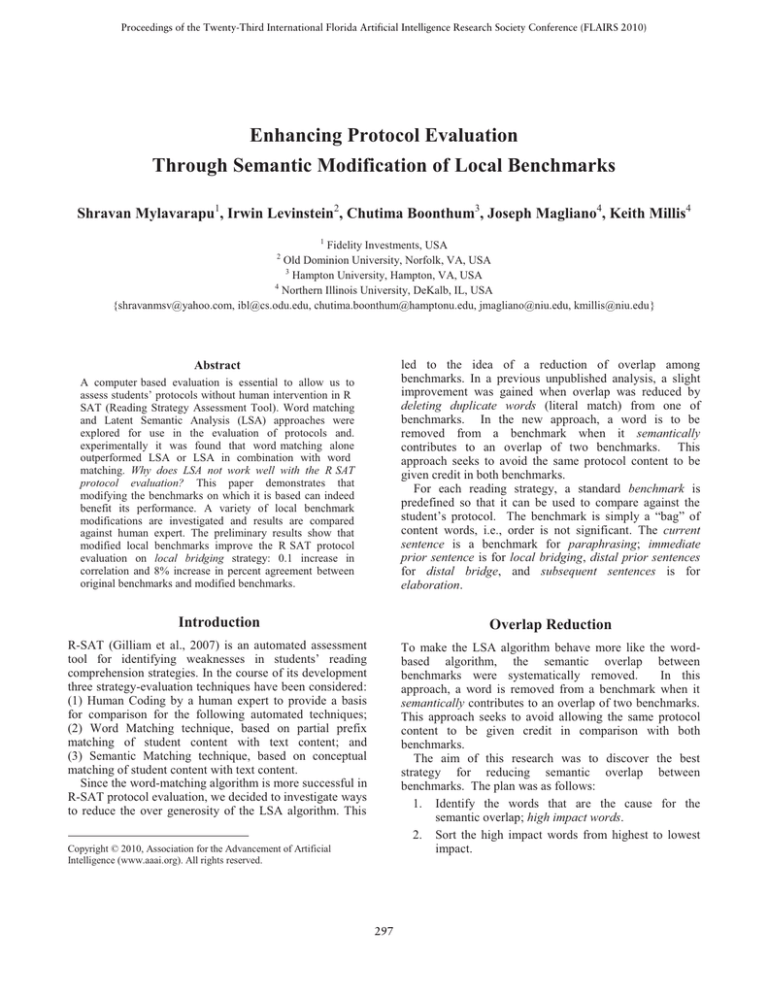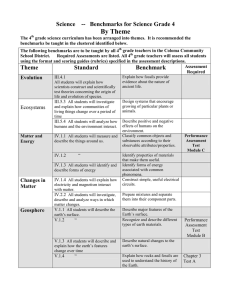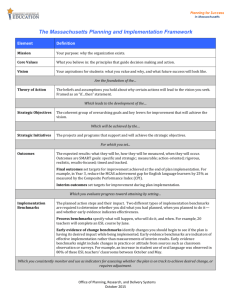
Proceedings of the Twenty-Third International Florida Artificial Intelligence Research Society Conference (FLAIRS 2010)
Enhancing Protocol Evaluation
Through Semantic Modification of Local Benchmarks
Shravan Mylavarapu1, Irwin Levinstein2, Chutima Boonthum3, Joseph Magliano4, Keith Millis4
1
Fidelity Investments, USA
Old Dominion University, Norfolk, VA, USA
3
Hampton University, Hampton, VA, USA
4
Northern Illinois University, DeKalb, IL, USA
{shravanmsv@yahoo.com, ibl@cs.odu.edu, chutima.boonthum@hamptonu.edu, jmagliano@niu.edu, kmillis@niu.edu}
2
A computer based evaluation is essential to allow us to
assess students’ protocols without human intervention in R
SAT (Reading Strategy Assessment Tool). Word matching
and Latent Semantic Analysis (LSA) approaches were
explored for use in the evaluation of protocols and.
experimentally it was found that word matching alone
outperformed LSA or LSA in combination with word
matching. Why does LSA not work well with the R SAT
protocol evaluation? This paper demonstrates that
modifying the benchmarks on which it is based can indeed
benefit its performance. A variety of local benchmark
modifications are investigated and results are compared
against human expert. The preliminary results show that
modified local benchmarks improve the R SAT protocol
evaluation on local bridging strategy: 0.1 increase in
correlation and 8% increase in percent agreement between
original benchmarks and modified benchmarks.
led to the idea of a reduction of overlap among
benchmarks. In a previous unpublished analysis, a slight
improvement was gained when overlap was reduced by
deleting duplicate words (literal match) from one of
benchmarks. In the new approach, a word is to be
removed from a benchmark when it semantically
contributes to an overlap of two benchmarks. This
approach seeks to avoid the same protocol content to be
given credit in both benchmarks.
For each reading strategy, a standard benchmark is
predefined so that it can be used to compare against the
student’s protocol. The benchmark is simply a “bag” of
content words, i.e., order is not significant. The current
sentence is a benchmark for paraphrasing; immediate
prior sentence is for local bridging, distal prior sentences
for distal bridge, and subsequent sentences is for
elaboration.
Introduction
Overlap Reduction
R-SAT (Gilliam et al., 2007) is an automated assessment
tool for identifying weaknesses in students’ reading
comprehension strategies. In the course of its development
three strategy-evaluation techniques have been considered:
(1) Human Coding by a human expert to provide a basis
for comparison for the following automated techniques;
(2) Word Matching technique, based on partial prefix
matching of student content with text content; and
(3) Semantic Matching technique, based on conceptual
matching of student content with text content.
Since the word-matching algorithm is more successful in
R-SAT protocol evaluation, we decided to investigate ways
to reduce the over generosity of the LSA algorithm. This
To make the LSA algorithm behave more like the wordbased algorithm, the semantic overlap between
benchmarks were systematically removed.
In this
approach, a word is removed from a benchmark when it
semantically contributes to an overlap of two benchmarks.
This approach seeks to avoid allowing the same protocol
content to be given credit in comparison with both
benchmarks.
The aim of this research was to discover the best
strategy for reducing semantic overlap between
benchmarks. The plan was as follows:
1. Identify the words that are the cause for the
semantic overlap; high impact words.
2. Sort the high impact words from highest to lowest
impact.
Abstract
Copyright © 2010, Association for the Advancement of Artificial
Intelligence (www.aaai.org). All rights reserved.
297
3.
4.
chosen local benchmarks no literal overlap. Now, looking
at the strategy that gave satisfactory results, we find that
Remove up to 3 words using threshold 0.4 appears to be the
best because of high d’ values and high correlation.
To verify the result, the data was split into two sets:
training set and test set. The predicted formulae are
obtained from the training set and applied on the test set.
Apply different strategies for removing these words
(A. Always remove n high impact words; B.
Remove up to n high impact words based on a
threshold of permissible overlap; or C. Remove up
to n% high impact words based on a threshold of
permissible overlap)
Determine which strategy yields revised protocols
that produce the best prediction of the human
evaluation of the strategy used in the protocols.
Method
Train
Test
Overall
R3T4:
Train
R3T4:
Test
R3T4:
Overall
Results
Correlation, percent agreement, and d’ (d-prime) between
the proposed method (semantic modification of
benchmarks) and human coding were calculated to show
the performance. The baseline of this analysis is the
original word matching algorithm’s result where overlap
between benchmarks is present. Four different base data
sets were used while experimenting. In the table below,
d’ 0 measures absence of a strategy; d’ 1, partial presence
and d’ 2, complete presence.
Method
ORG
R1
R2
R3
R3T1
R3T2
R3T3
R3T4
R
0.345
0.356
0.335
0.339
0.374
0.400
0.433
0.450
%
67.7
75.3
76.3
76.7
75.9
76.1
76.0
75.3
d' 0
1.124
1.182
1.219
1.294
1.213
1.302
1.451
1.480
d' 1
0.590
0.486
0.413
0.345
0.551
0.629
0.741
0.752
R
0.310
0.319
0.313
0.318
0.351
0.373
0.407
0.425
%
68.5
75.4
76.1
76.5
75.6
75.8
75.9
75.5
d' 0
1.086
1.178
1.190
1.242
1.200
1.280
1.430
1.484
d' 1
0.704
0.702
0.592
0.544
0.627
0.732
0.838
0.914
%
67.7
67.6
67.6
d' 0
1.084
1.259
1.110
d' 1
0.803
0.749
0.765
d' 2
0.770
0.437
0.563
0.510
78.1
1.640
0.871
1.027
0.384
74.8
1.428
0.949
0.500
0.421
75.8
1.485
0.923
0.667
Table 3: Mechanically chosen local benchmarks with overlap: split data
This result confirms that removing up to 3 words using
threshold 0.4 is the best benchmark modification method
for local benchmark. Focusing only presence (1 and 2
combined) or absence (only 0) of such strategy is also
significant.
d' 2
0.810
0.855
0.767
0.738
0.935
0.963
0.918
0.976
Method
R3T4
R
0.495
%
82.6
d' 0
2.747
d' 2
2.747
Table 4: Mechanically chosen local benchmarks with overlap: focusing on
absence and presence of a local bringing strategy.
Table 1: Mechanically chosen local benchmarks with overlap
ORG Original result from word based algorithm (no overlap)
R1 Always remove 1 word
R2 Always remove 2 words
R3 Always remove 3 words
R3T1 Remove up to 3 words using threshold 0.1
R3T2 Remove up to 3 words using threshold 0.2
R3T3 Remove up to 3 words using threshold 0.3
R3T4 Remove up to 3 words using threshold 0.4
R Correlation compare to human coding
% Percent agreement against human coding
Method
ORG
R1
R2
R3
R3T1
R3T2
R3T3
R3T4
R
0.318
0.300
0.306
Conclusion
Modifying local benchmarks by removing the high impact
word showed a significant improvement in the R-SAT
evaluation. With this, we are able to identify whether the
student has used local bridging strategy in their input.
This is a good indication that LSA definitely benefit and
can be used for R-SAT strategy evaluation.
References
Gilliam, S., Magliano, J.P., Millis, K.K., Levinstein, I.B.,
and Boonthum, C. 2007. Assessing the format of the
presentation of text in developing a Reading Strategy
Assessment Tool (R-SAT). Behavior Research Methods
Instruments and Computer, 39 (20), 199-204.
Landauer, T.K., McNamara, D.S., Dennis, S., and Kintsch,
W. eds. 2007. Handbook of Latent Semantic Analysis.
Lawrence Erlbaum, Mahwah, NJ.
McNamara, D.S., Boonthum, C., Levinstein, I.B., and
Millis, K.K. 2007. Evaluating self-explanation in iSTART:
Comparing word-based LSA systems. T. Landauer, D.S.
McNamara, S. Dennis, and W. Kintsch eds., Handbook of
Latent Semantic Analysis (pp. 227-241). Lawrence
Erlbaum, Mahwah, NJ.
d' 2
0.608
0.570
0.592
0.573
0.702
0.708
0.686
0.761
Table 2: Mechanically chosen local benchmarks no literal overlap
The correlation and d’ values appeared satisfying
although the % agreement was a little low compared to
298





